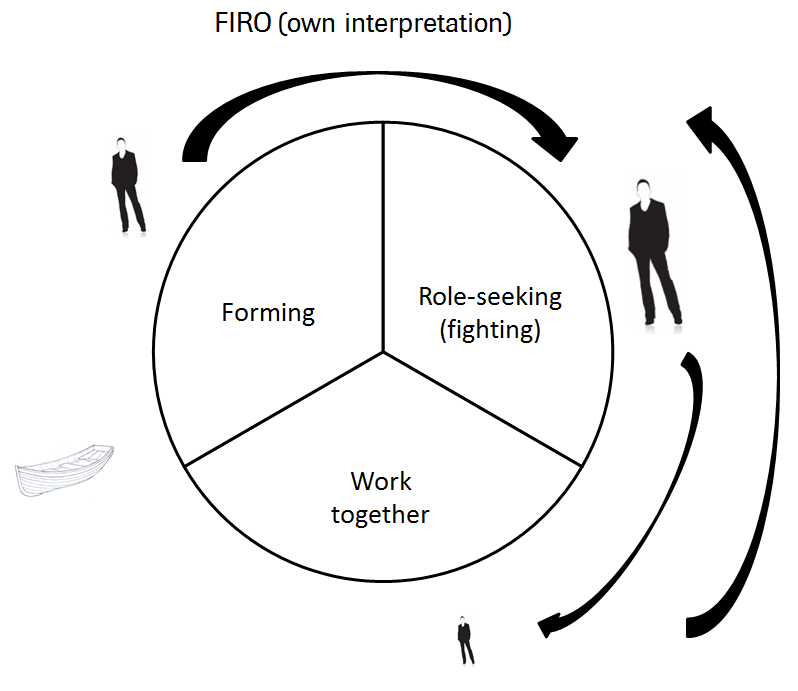Are you interested in leadership theory around team-psychology? 2006 I attended a course called “UGL – Understanding Group and Leader” in Sweden. One model that I found very useful, and have applied to various positions in my work-life has been a version of the “FIRO-circle”. I think it gives a great “beginners perspective” to group dynamics. FIRO stands for “Fundamental Interpersonal Relations Orientation). I won’t go in to more history than that, hey that’s what Wikipedia is for (
Click here for FIRO). Instead, I’m going to jump directly in to the model and discuss the application and why it’s so interesting that I chose to write about it.
Have you ever felt new in a work group and been curious about what’s happening when people meet for the first time or if a new person join a team? Let’s think about the team as people in a boat. The first thing that happens is that you, on a personal level, make a decision whether you want to be in the boat or not. You learn to know people around you by asking risk-free questions without any heavy political load or anything that may be received as offensive. You tell “fishing stories”. What did you do before this job? Where do you live? Very early in the group “forming”-phase we get to know each other, and if we decide to stay in the boat, we become a team. Here you may get a nice comfortable feeling, sometimes described as the “honey moon”. All feels good and you like each other.
After a while, conflicts start to come though. The group is trying to find their roles within the team, and small groups can soon be spotted. John always sits next to Jane. Tom seems to want to hang out with Jim rather than the rest of the group. When approached with a task that demands collaboration, some team members are very vocal and tend to not listen to others, while others are more silent. At one point open arguments and fights may be experienced. Sometimes conflicts settles (unresolved) and the team goes back in to their normal, semi-happy pace. In order for the team to become a high-performance team, the conflicts need to be addressed properly. If not, there will always be minor fights. This area is huge and consists of many tools that the manager and the team can use to try to align and overcome their conflicts. Feedback, in a constructive way, sometimes facilitated meetings and setting clear roles and giving the right conditions certainly helps the team achieve this. The key is to see the conflict as something good that can take the team to the next level. It’s crucial that the team manager facilitates meetings and set clear roles during this phase, in order for the team to get its structure. Boss is big.
For the (actually sadly very few) teams that are able to work out their differences and focuses on delivering, they will enter something described as the “work together”-phase. Being a part of a team here is great. You have the feeling of working with your best friends, but also feel respected and that your work is needed and honored. You get the attention you deserve and you understand both the why and the how. You get the appraisal from your manager. Even outside the safe walls of the team. When new tasks come in, the team works out a good way to assign these among them. There will be new conflicts, but the team knows that handling a conflict early, before it turns in to a bomb, is crucial to all their well-being. Nothing is swept under the carpet. The team respects their manager and feels safe about their roles and is delivering well. During this phase the team manager trusts the team and let them self-organize. Boss is small.
But. The manager, who was so successful in facilitating the teams development from “zeroes to heroes” – has now got a promotion. What happens now to the team? This has been the key of writing this post. As a manager of the manager, team member, or sometimes customer, it could be of interest to understand that the team will now move back to the “role seeking” (fighting)-phase. Oh no! All the effort invested in working together, good discussion climate and respecting each other, now goes right out the window and in to the Rhein. Not quite. This is a team dynamic process that needs to be managed. Again, the boss needs to be big. Set clear expectations for the team, emphasize on roles and use all the tools they have under their belt to help the team move to the “work together”-phase again. How fast it goes depends on how good the team has been able to work together before. Once a team has been in the “work together”-phase, they really want to get back.

Disclaimer: Please note that in the text above I’m touching many very broad fields, and the intention is only to show a theory about group dynamics when a manager (leader) changes, and not explain (or show models) of the entire subject of group psychology.

